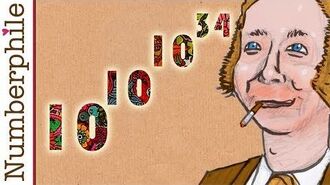The first Skewes number, written \(Sk_1\), is an upper bound for the least number \(n\) such that \(\pi(n) > li(n)\) is true, where \(\pi(n)\) is the prime counting function and \(li(n)\) is the logarithmic integral. This bound was first proven assuming the Riemann hypothesis.[1] It's equal to \(e^{e^{e^{79}}} \approx 10^{10^{10^{34}}}\).[2][3] The number is named after Stanley Skewes, who found the bound in 1933.
The second Skewes number, \(Sk_2\), is a closely related upper bound for the least number \(n\) such that \(\pi(n) > li(n)\) holds, but this bound, as opposed to the previous one, was proven without assumption of the Riemann hypothesis. It is equal to \(e^{e^{e^{e^{7.705}}}}\) ~ \(10^{10^{10^{963}}}\), which is larger than the original Skewes number.
As of now, it is known that the least example \(n\) of \(\pi(n) > li(n)\) must lie between \(10^{19}\) and \(1.4 \cdot 10^{316}\).
Leading digits of exponent[]
We don't know if it's possible to calculate the leading digits of either Skewes number, but we can compute the leading digits of their base-10 logarithms. The following transformation shows this (for \(Sk_1\)):
\(e^{e^{e^{79}}} = e^{10^{e^{79} \times log(e)}} = 10^{10^{e^{79} \times log(e)} \times log(e)} = 10^{10^{e^{79} \times log(e)+log(log(e))}}\). On the big number calculator: \(10^{e^{79} \times log(e)+log(log(e))} = 35,536,897,484,442,193,330...\), so \(Sk_1 = 10^{35,536,897,484,442,193,330...}\)
Also, similarly, \(Sk_2 = 10^{2,937,727,533,220,625,115,1...}\)
Approximations in other notations[]
First Skewes number:
| Notation | Approximation |
|---|---|
| Arrow notation | \(24\uparrow\uparrow4\) |
| Bowers' Exploding Array Function | \(\{10,\{10,\{10,34\}\}\}\) |
| Chained arrow notation | \(24\rightarrow4\rightarrow2\) |
| Hyper-E notation | \(\mathrm{E}34\#3\) |
| Hyperfactorial array notation | \(((30!)!)!\) |
| Scientific notation | \(10^{10^{8.5\times10^{33}}}\) |
| Steinhaus-Moser Notation | \(23[3][3][3]\) |
| Strong array notation | \(s(10,s(10,s(10,34)))\) |
| Fast-growing hierarchy | \(f_2(f_2(f_2(108)))\) |
| Hardy hierarchy | \(H_{\omega^{2}\times3}(108)\) |
| Slow-growing hierarchy | \(g_{\omega^{\omega^{\omega^{34}}}}(10)\) |
Second Skewes number:
| Notation | Approximation |
|---|---|
| Arrow notation | \(374\uparrow\uparrow4\) |
| Bowers' Exploding Array Function | \(\{10,\{10,\{10,963\}\}\}\) |
| Chained arrow notation | \(374\rightarrow4\rightarrow2\) |
| Hyper-E notation | \(\mathrm{E}963\#3\) |
| Hyperfactorial array notation | \(((435!)!)!\) |
| Scientific notation | \(10^{10^{3.3\times10^{963}}}\) |
| Steinhaus-Moser Notation | \(373[3][3][3]\) |
| Strong array notation | \(s(10,s(10,s(10,963)))\) |
| Fast-growing hierarchy | \(f_2(f_2(f_2(3189)))\) |
| Hardy hierarchy | \(H_{\omega^{2}\times3}(3189)\) |
| Slow-growing hierarchy | \(g_{\omega^{\omega^{\omega^{963}}}}(10)\) |
Sources[]
- ↑ Skewes Number
- ↑ Edward Kasner, James Roy Newman. Mathematics and the Imagination Originally published by Simon and Shuster, 1940. Dover Edition published in 2001. ISBN 978-1556151040 p.32
- ↑ Conway and Guy. The Book of Numbers. Copernicus. 1995. ISBN 978-0387979939 p.145
See also[]

Skewes' Massive Number - Numberphile
